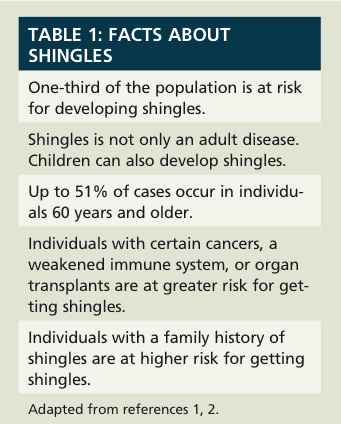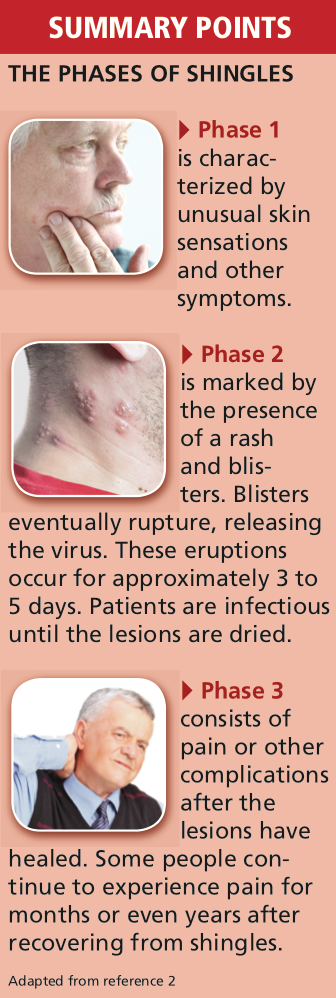Soothing Shingles
One in 3 individuals is at risk for developing shingles.
One in 3 individuals is at risk for developing shingles.
What Is Shingles?
Shingles is an outbreak of rashes and blisters on the skin. It is caused by the same virus that causes chickenpox. Once an individual has had chickenpox, the virus stays in the body in an inactive state. Years later, the virus can become active, causing shingles.
The first symptoms of shingles are unusual skin sensations. These include pain, itching, and tingling. Other symptoms include confusion, fatigue, fever, headache, memory loss, an upset stomach, and stomach pain.1 These symptoms generally occur 1 to 5 days before a painful rash appears on one side of the body or face. In most people, the rash develops on the torso and extends to the front and the back of the body. The rash forms very painful blisters that typically become scabs in 7 to 10 days. Most cases of shingles clear up within 2 to 4 weeks. For more information, see Table 1 and “Phases of Shingles.”

Is Shingles Contagious?

Shingles is highly contagious. The virus is spread through direct contact with fluid from the blisters. The virus cannot be transmitted to others by sneezing, coughing, or casual contact. Table 2 lists guidelines for preventing transmission of the virus to others.
How Is Shingles Treated?
There is no cure for shingles. Treatment focuses on the relief of symptoms. Three medicines have been approved to treat shingles. These medicines help reduce the duration and severity of the illness. Your doctor will select one of the medicines based on your medical condition. To be effective, the medicine must be started as soon as possible after the rash appears. Ideally, treatment should begin within 96 hours of exposure to shingles.3
If you think you might have shingles, call your doctor immediately to discuss treatment options. Your doctor may also prescribe medication for pain. Several medications developed for other conditions also help reduce pain. For example, a drug approved for patients with seizures reduces shingles pain by 50%.2 Wet compresses, calamine lotion, and oatmeal baths help relieve some of the itching. Shingles can lead to several complications (Online Table 3).
Table 3: Complications from Shingles
• Elderly people have the greatest risk for complications.
• 20% of patients experience pain following shingles.
• 10% of patients with shingles experience pain lasting more than 3 months .
• The rash may become infected. Antibiotics are used to treat infections.
• Skin color may change. White patches may appear where the rash and blisters first appeared.
• A facial nerve may become infected. Symptoms include earache, deafness, dizziness, and paralysis of the face.
• Ulcers and scarring may occur on the surface of the eye.
• The brain may become inflamed.
• People who have shingles are more likely to have a stroke.
Adapted from references 2, 4, and 5.

A vaccine to prevent shingles has been available since 1995. Getting vaccinated is the only way to reduce the risk of developing shingles. It also reduces the pain that can follow shingles.6 A person can be vaccinated at any age. The FDA recommends vaccination for people 50 years or older.
A person who is vaccinated may still develop shingles, but the severity and complications are reduced.6 Vaccination reduces the risk of getting shingles by 51%. It also reduces the risk of long-term pain by 67%.2 Research suggests that the vaccine is effective for at least 6 years. Research is being conducted to determine how long the vaccine protects people. The vaccine is generally safe and well tolerated.7 Common side effects of getting vaccinated are redness, soreness, swelling, or itching at the needle site.8 Affected individuals can get vaccinated within the first few days after the rash appears.
The shingles vaccination includes live viruses. It is not recommended for all people. Individuals should not get vaccinated if they are on certain medications, have a weakened immune system, have certain cancers, or have transplanted organs. Prior to getting vaccinated, ask your doctor if you have a condition that may prevent you from getting vaccinated. Some people who get the shingles vaccine may develop a rash near the place where they were vaccinated. As a precaution, the rash should be covered until it disappears.1
For More Information
The Centers for Disease Control and Prevention (www.CDC.gov) provides easy-to-read information about shingles.
Dr. Zanni is a psychologist and health-systems consultant based in Alexandria, Virginia.
References:
- Shingles (herpes zoster). Centers for Disease Control and Prevention website. www.cdc.gov/shingles/vaccination.html. Accessed November 22, 2013.
- Moon J. Diagnosis and management of herpes zoster. Medscape website. www.medscape.org/viewarticle/724974. Accessed November 22, 2013.
- Vegar C. Updated guidelines for varicella zoster immune globulin. Medscape website. www.medscape.org/viewarticle/809244. Accessed November 22, 2013.
- What is shingles? what causes shingles? Medical News Today website. www.medicalnewstoday.com/articles/154912.php. Accessed November 22, 2013.
- Nalamachu S, Morley-Forster P. Diagnosing and managing postherpetic neuralgia. Drugs Aging. 2012;29:863-869.
- Shingles information page. National Institute of Neurological Disorders and Stroke website. www.ninds.nih.gov/disorders/shingles/shingles.htm. Accessed November 22, 2013.
- Galea SA, Sweet A, Beninger P, et al. The safety profile of varicella vaccine: a 10-year review. J Infect Dis. 2008;197(suppl 2):S165-S169.
- Shapiro M, Kvern B, Watson P, Guenther L, McElhaney J, McGeer A. Update on herpes zoster vaccination: a family practitioner’s guide. Can Fam Physician. 2011;57:1127-1131.
